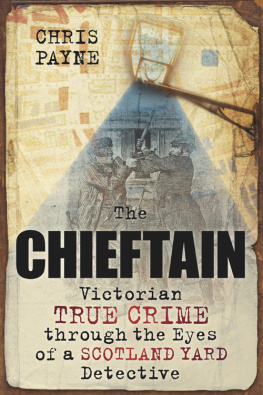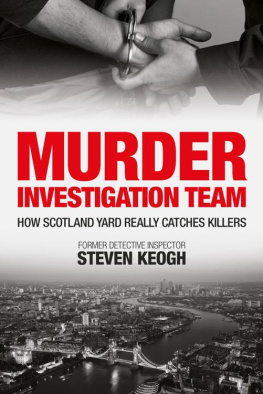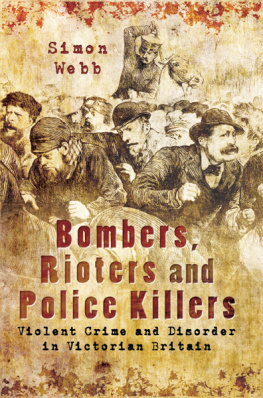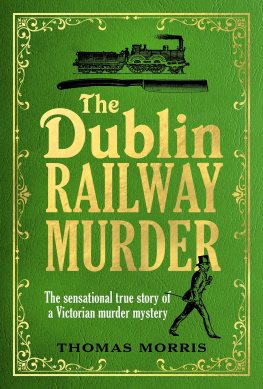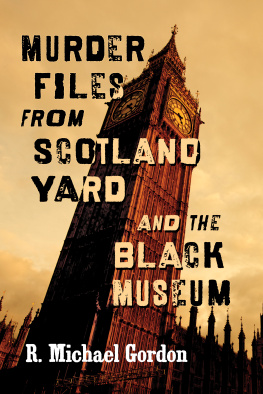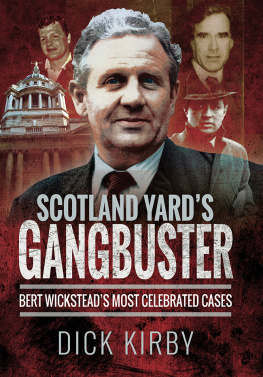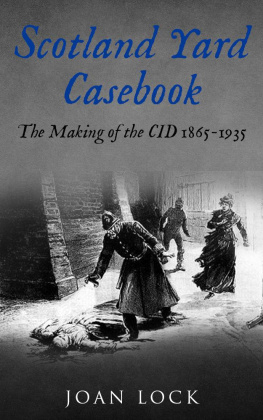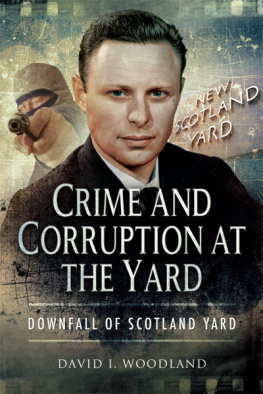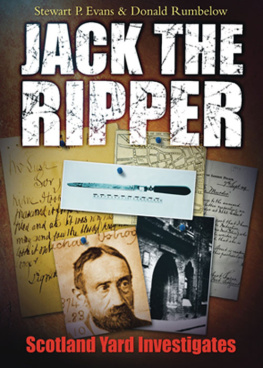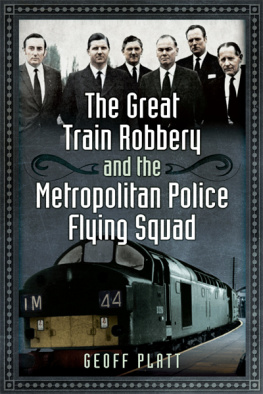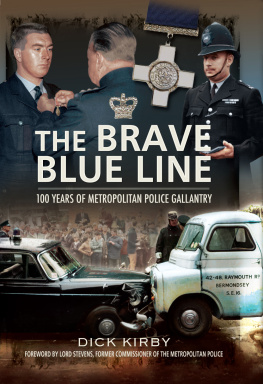To Meg, Kate and Rob
CONTENTS
This book has only been feasible because of the patience, support and encouragement that I have received from my wife Meg and our children, Robert and Katherine. The realisation that one of my great-great-grandfathers had been a detective in the London Metropolitan Police emerged from research that I was undertaking on family documents written by my grandfather, Charles Payne. Without these papers and the care taken to preserve them by my grandmother, Ida Payne, and my father, Rupert Payne, there would have been no such book.
The research that I have undertaken has been greatly assisted by a number of outstanding national and regional archives and libraries. In particular, my thanks go to the following organisations and their staff: The National Archives (Kew), the British Library (St Pancras) and the British Newspaper Library (Colindale), Westminster City Archives, the Parliamentary Archives London, the Metropolitan Police Historical Collection, Cumbria Libraries (Kendal), Lancashire Libraries (Carnforth), Warrington Library, the Bodleian Library at Oxford University, the University of Lancaster Library and the Library and Museum of Freemasonry. Online facilities that have been invaluable have included Wikipedia, Ancestry.co.uk, Old Bailey Proceedings online, the Cengage digital archives of The Times and nineteenth-century British Library Newspapers.
I have been helped and advised by several people who have read and commented on draft sections of the book. Clive Bravery and Robert Payne have kindly read all chapters and provided helpful comments. Vincent Comerford, Padraic Kennedy, Rohan McWilliam, Canice OMahony, Michael McCarthy, Stefan Petrow and Niall Whelehan have given me the benefit of their academic expertise on individual chapters. Particular thanks go to Niall Whelehan for introducing me to the first-hand accounts of the Fenian conspiracy written by Octave Fariola, and to Padraic Kennedy for providing me with references to George Clarke that he had located in the National Archives of Ireland. Other individuals who have provided information and encouragement that has been beneficial to the content and progress of this book include: Nene Adams, John Archer, Phillip Barnes-Warden, the late Maggie Bird, Phillip Bonney, Andrew Brooks, Sioban Clarke, His Honour Judge Peter Clarke, Nanette and Michael Crenol, Paul Dew, Gillian and Graham Douglas-Smith, Rod Elwood, Clive Emsley, Anne Featherstone, Martin Hagger, John Hicks, Carla King, Joan Lock, Peter and Jonathan Meiklejohn, Alan Moss, Neil Paterson, Paul Rason, Keith Skinner, Linda Stratmann, Eileen Summers, Donald Thomas, Margaret Webb and the members of the South Lakes U3A Genealogy Group. The final content and style, as well as any overlooked errors and omissions are, of course, my responsibility.
I would also like to thank Diane Clements of the Library and Museum of Freemasonry, Freemasons Hall, London, for permission to include information on George Clarkes membership of the Freemasons. For advice on copyright issues affecting text and images from documents held in the National Archives, I am most grateful for the guidance received from Tim Padfield and Paul Johns.
I am most grateful for permission to include extracts from the following sources:
Axon Ballads, No 16 (Chethams Library)
Bowen-Rowlands, Ernest, Seventy-Two Years at the Bar (Macmillan Publishers, 1924)
Comerford, Vincent, The Fenians in Context: Irish Politics and Society, 184882 (Wolfhound Press, 1985)
Howard, Sharon, Old Bailey Proceedings Online (University of Sheffield, 2010)
Jenkins, Brian, The Fenian Problem (McGill-Queens University Press, 2008)
Kennedy, Padraic, Intelligence and National Security (18, 2003), pp. 10027
OMahony, Canice and Ferguson, Kenneth, The Irish Sword (22, 2000), pp. 3650
Petrow, Stefan, Policing Morals: The Metropolitan Police and the Home Office, 18701914 (1994, by permission of Oxford University Press, Inc.)
Ridley, Jasper, The Freemasons (Constable & Robinson, 1999)
Thurmond Smith, Phillip, Policing Victorian London (Copyright 1985, reproduced with permission of ABC-CLIO, Santa Barbara, CA, USA)
Images have been reproduced with the permission of the copyright or collection holders, where appropriate. Thanks are due to:
Mary Evans Picture Library for photographs of Sir Richard Mayne, the Earl of Cardigan, Fenian Guy Fawkes, Michael Davitt, Sir George Lewis and Sir Edward Clarke
Getty Images for photographs of Charles Bravo and Florence Bravo
Peter Meiklejohn for the photograph of John Meiklejohn
Kjell Hoel and Brian Attree for the photograph of George Hammond Whalley
The National Archives for photographs of William Henry Walters, Charles Howard, Harry Benson, Charles Bale, Frederick Kurr and Edward Froggatt; with particular thanks to Paul Johnson
The Metropolitan Police Historical Collection for the photographs of Superintendent Robert Walker and A Division colleagues and of Sir Edmund Henderson
The Parliamentary Archives, London for photographs of the Tichborne Claimant and Sir Richard Assheton Cross
Every effort has been made to secure necessary permissions to reproduce copyright material, though in some cases it has proved impossible either to trace copyright holders or to generate a response. If any omissions are brought to my notice, I will be pleased to include appropriate acknowledgements on reprinting. A small number of corrections to the original text have been incorporated prior to the production of the ebook format in 2013.
Finally, I would like to express my gratitude to Reuben Davison for introducing the concept of this book to The History Press, and to thank Simon Hamlet, Lindsey Smith, Chrissy McMorris, Abbie Wood and the team at The History Press for their enthusiasm and skill in generating the finished product.
Many people read about detectives, and they see things upon the stage about detectives, and they think it is a very good sort of life; but when they come to try it they find it is earning your livelihood, like lifting bricks and everything else, and they get tired of it.
Superintendent James Thomson, 1877
Many of us enjoy a good crime story and can readily recall the names of our favourite fictional detective, whether it be Sherlock Holmes, Sexton Blake, Philip Marlowe, Hercule Poirot, Maigret, Morse, Rebus, Wallander or many others. Fewer of us, I suspect, can recall the names or exploits of those who investigate crime in the real world. Thus when I discovered that one of my ancestors, George Clarke, had been a detective chief inspector in the London Metropolitan Police in the 1870s, it meant little to me. It was only later that I found some information that was sufficient to persuade me that his story would be an intriguing one to investigate. During my research, it soon became obvious that George Clarke had been a leading figure at Scotland Yard and was well known by the Victorian London public, especially those who crossed the boundary from legality to crime. Indeed, when it comes to Victorian detectives Clarke was the real thing, but his story has essentially remained untold until now. This book sets out to open up the world of Victorian crime and the diverse investigations of the early Scotland Yard detectives, through Clarkes eyes and experiences.
In 1840, at 21 years of age, George Clarke joined the London Metropolitan Police. After twenty-two years service he had only achieved promotion to sergeant, but, in 1862, he was transferred to the small group of nine detectives that then constituted the plain-clothed detective department at Scotland Yard; the only detectives within the Metropolitan Police at that time. By May 1869 Clarke had risen to the rank of detective chief inspector and, by his retirement in January 1878, he had been second-in-command of the department for nine years. By that time he had become known to colleagues and to members of the criminal fraternity as The Chieftain or The Old Man.
Next page
